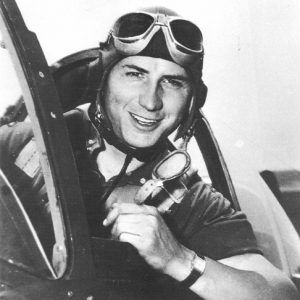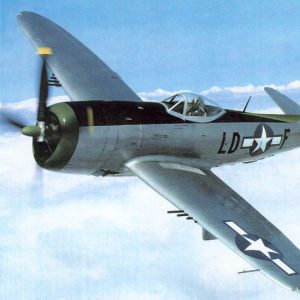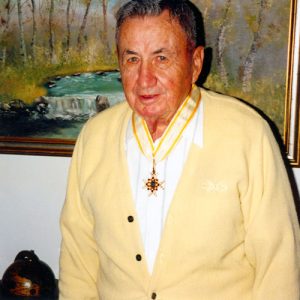calsfoundation@cals.org
Paul Page Douglas Jr. (1919–2002)
Brigadier General Paul Page Douglas, a Paragould (Greene County) native and an air force “ace,” was one of the most highly decorated fighter pilots from 1940 to 1970. In 1940, he joined the Arkansas National Guard, and he retired as commander of the 836th Air Division at MacDill Air Force Base, Florida, in 1970. The tactics he developed for the P-47 Thunderbolt during World War II made that plane one of the most successful fighter planes of the war.
Douglas was born in Paragould on April 23, 1919, to Bess Douglas and Paul Page Douglas. His father was a conductor on the Missouri Pacific Railroad. Douglas attended public schools in Paragould and graduated from high school in 1938. That fall, he enrolled at Arkansas State Teachers College (ASTC), now the University of Central Arkansas (UCA) in Conway (Faulkner County), where he became a cheerleader and a reporter for the college newspaper, the Echo. He also earned his private pilot’s license while at ASTC. After war broke out in Europe, he joined the Arkansas National Guard and was called to active duty in 1941. He entered the aviation cadet program on April 28, 1941, and received his wings and commission as a second lieutenant the following December 12, just five days after the Japanese attack on Pearl Harbor.
Flying the P-47 Thunderbolt, Douglas logged a total of 136 missions and 337 combat hours while serving as commander of the 396th Fighter Squadron, vice commander of the 368th Fighter Group, and later with the Thirty-sixth Fighter Group in Belgium, France, and Germany. On two occasions, he shot down three enemy aircraft in one flight. He was recommended for the Medal of Honor and twice received the Distinguished Service Cross, at that time the nation’s second-highest military decoration. Douglas was credited with shooting seven enemy aircraft in the air and destroying twenty-seven enemy planes on the ground.
During the early days of air combat in Europe, Douglas and his pilots in the 368th Fighter Group were credited with developing the tactical strategies that made the newly delivered Republic P-47 Thunderbolt one of the most successful fighter planes of World War II. Traditionally, fighter planes were single-engine, single seat, small, and agile. But because of the Thunderbolt’s space-consuming, supercharged turbo engine system, the weight and size penalized pilots who had trained in the traditional lightweight aircraft. The “Jug,” as many called it because of its shape, was designed as a high-altitude bomber-interceptor rather than a “dogfighter.” It performed well at high altitudes, had an excellent dive performance and great firepower, was incredibly sturdy, could absorb heavy damage, and had outstanding pilot protection. However, because of its weight and size, it made wide turns and had a low zoom capability and low climb rate. Douglas soon discovered that with pilot training accommodating the plane’s high-speed dive performance, the P-47 could be used as an excellent fighter as well as a bomber-interceptor.
Because of the Thunderbolt’s versatility, pilots under Douglas’s command were assigned the unusual task of intercepting German V-1 rockets aimed at England. In the first ten days of the fall 1944 blitz, more than 1,000 V-1 rockets were launched toward England. As they soared over the English Channel at about 5,000 feet, flying at 330 to 380 miles per hour, pilots in Douglas’s Thirty-Sixth Fighter Wing flew in two-plane formations five to ten miles out to sea and used the P-47’s high-speed dive capability to close in to a good attacking range. They destroyed forty-seven percent (494) of the flying bombs with comparative ease during the blitz.
Douglas met Sarah Lee Chandler in Corpus Christi, Texas, before his transfer to England. They corresponded for over three years and married on December 23, 1944, while he was on a short leave; three weeks later, Douglas returned to his command. They had two daughters and a son.
Douglas had two years of college to his credit. After the war and his return to Texas, he was encouraged by the U.S. Army Air Force to obtain a BS degree. He enrolled in Texas Christian University (TCU) in Fort Worth and earned a degree in business administration. Following graduation from TCU in 1948, Douglas and his wife were stationed in Germany, where he joined his former wartime unit, the Thirty-sixth Fighter Wing, at Frustenfeldbruck. There, he commanded the Twenty-second Fighter Squadron until he returned to the United States in 1950.
His first assignment was as jet operations officer at the Tactical Air Command Headquarters at Langley Air Force Base in Virginia. He served in a variety of capacities in the United States and abroad, including instructing the first class at the Air-Ground Operations School at the Ninth Air Force Headquarters; commanding the Twenty-first Fighter Bomber Group; attending the North Atlantic Treaty Organization (NATO) Defense College in Paris, France; commanding the 1400th Operations Group in Keflavik, Iceland; working for the Office of the Inspector General of the United States Air Force; and commanding the Forty-first Air Division in Yokota, Japan.
On January 24, 1968, he assumed command of the 388th Tactical Fighter Wing at the Korat Royal Thai Air Force Base in Thailand. A command pilot, he flew the F-105 Thunderchief in 101 missions over North Vietnam. His airplane was nicknamed the “Arkansas Traveler.” In February 1969, Douglas assumed command of the 836th Air Division at MacDill Air Force Base in Florida.
Douglas retired as a brigadier general on February 1, 1970, having flown four different airplanes over the course of his career. Earning over sixty decorations, Douglas was one of the most decorated flyers in air force history. Following his retirement, he and his wife moved to Conway, where he joined the staff of the University of Central Arkansas. During the next thirteen years, he served as the purchasing agent at the university and operated a cattle farm in nearby Greenbrier (Faulkner County). In 1983, Douglas acquired ranch property in Bertram, Texas. He built a home and moved his family and cattle operation there the following year.
Douglas died on December 26, 2002. He is buried in the Central Texas State Veteran’s Cemetery in Killeen, Texas.
For additional information:
Chant, Chris. Air Warfare. London, England: Octopus Books Limited, 1979.
Emde, Heiner. Conquerors of the Air: The Evolution of Aircraft, 1903–1945. New York: Viking Press, 1968.
Fitzsimons, Bernard. Jet Fighters and Bombers. Secaucus, NJ: Chartwell Books Inc., 1976.
Green, William, and Gordon Swanborough. The World’s Great Fighter Aircraft. New York: Crescent Books, 1981.
Joiner, Susan, ed. Fighting Aircraft of World Wars One and Two. New York: Crescent Books, 1976.
Office of the Assistant Chief of Air Staff, Intelligence. Impact: The Army Air Forces’ Confidential Picture History of World War II. Vol. 2. New York: James Parton and Company, 1980.
Mack Hamblen
Germantown, Tennessee








Comments
No comments on this entry yet.